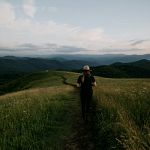Emma Johnson discover the beauty of the modern pilgrimage - a new kind of spiritual journey, that is less about connecting ourselves with God and more about connecting us with ourselves...
“Walk alone, across mountains or through forests. You are nobody to the hills or the thick boughs heavy with greenery.” (Frederic Gros)
Centuries ago, pilgrimage was a vital part of our spiritual and physical lives. Journeying on foot to holy places filled our leisure time and met many of our spiritual needs. Today, as the modern world reaches its tentacles into every aspect of society, and especially into religion, pilgrimage has become a relic of the past, something confined to the dusty annals of a more faith-driven world, something we don’t have the time – or need – for anymore.
And yet, almost as a reaction to the pressures of the modern world, there has recently been a resurgence in people’s desire to undertake great journeys. Attempts to climb Everest, for instance, have never been higher, while over 300,000 people a year now walk the famous Christian path of the Camino de Santiago and over two million Muslims descend on the Hajj each year. As matters of the soul are considered less and less important, many of us are seeking to reclaim this spiritual, personal imperative in any way that we can.
“The truth is, we are wired for long walks and thinking time,” writes Steve Watkins author of ‘Pilgrim Steong. “Restless souls across the religious spectrum and dating back 2000 years before Christ have practiced pilgrimage in search of a greater understanding about themselves, and life.”
For some people, pilgrimage breaks down to the simple importance of the act itself, of the process of continuing to move forward, putting one step in front of the other – even if our motivations for doing so are diverse and deeply personal. In his wonderful memoir, 'A Philosophy of Walking' author Frederic Gros says that what sets us out on our path is only half the journey. “None of your knowledge, your reading, your connections will be of any use here: two legs suffice, and big eyes to see with. Walk alone, across mountains or through forests. You are nobody to the hills or the thick boughs heavy with greenery. You are no longer a role, or a status, not even an individual, but a body, a body that feels sharp stones on the paths, the caress of long grass and the freshness of the wind.”
Paring back our experience to the simplicity of our steps is something deeply attractive in a world where our experiences continue to be more heightened, our senses more constantly stimulated. And for some, the slowness of the journey is precisely where its beauty lies, because the slower you go, the more you can see. “As a pilgrim, travel is made holy in its slowness,” says Kevin A. Codd author of ‘Beyond Even the Stars’ who also undertook the Santiago a Compostela pilgrimage. “I see things that neither the passengers of [a] train nor the drivers of the automobiles see. I feel things that they will never feel. I have time to ponder, imagine, daydream. I tire. I thirst. In my slow walking, I find me.”
The Journey into Self
Finding ourselves is perhaps at the absolute core of the modern pilgrimage, so much so that some people do not even see it as a physical journey. “Many believe a pilgrimage is about going away but it isn’t; it is about coming home,” says L.M Browning is her book Season of Contemplation. “Those who choose to go on pilgrimage have already ventured away from themselves; and now set out in a longing to journey back to who they are. We do not need to go to the edges of the earth to learn who we are, only the edges of ourselves.”
This is a beautiful way to describe a journey into oneself, a feature that seems especially prevalent in the journeys of women in the past decade. Taking on pilgrimages of their own, across the globe, both following well-trodden paths and breaking new ground, women are walking to find something. And whether they choose a long-distance trail, the ascent of an awe-inspiring mountain, a journey to a temple or a walk through a new wilderness, the common thread running through every journey is the opportunity to step out of their day-to-day routine and follow a path that promises meaning, discovery and the space to breathe.
In every case, the route is important, but the destination sometimes less clear. Not always a fixed geographical point, sometimes these journeys become more about arriving at an emotional or mental point, which the process of walking has guided us to.
Walking Your Own Path
A perfect example of this is of course Cheryl Strayed’s breakout memoir Wild: From Lost to Found on the Pacific Crest Trail, in which she documented not only her journey along the Pacific Crest Trail, but also her journey through grief, divorce, recovery from substance abuse and towards self-love. “It had nothing to do with gear or footwear or the backpacking fads or philosophies of any particular era or even with getting from point A to point B,” she says. “It had to do with how it felt to be in the wild. With what it was like to walk for miles with no reason other than to witness the accumulation of trees and meadows, mountains and deserts, streams and rocks, rivers and grasses, sunrises and sunsets. The experience was powerful and fundamental.”
Strayed, who changed her surname to ‘Strayed’ before her pilgrimage, because she felt it reflected part of her journey, straying from life’s normal path and from her old way of life, understood that in seeking to find herself, she first had to get lost. “I'd finally come to understand what it had been: a yearning for a way out, when actually what I had wanted to find was a way in.”
And, while walking forms perhaps the central tenet of the pilgrimage, it’s good to remember that if we are open, every journey can expose our truths. For many people it is simply the act of making a journey with a specific intent, and being present to what happens as you travel that can shape our experiences.
Perhaps writer Elizabeth Gilbert, whose journey in search of prayer, love and nourishment led her to cross the globe to Italy, India and Indonesia, and eventually to writing her bestselling memoir Eat, Pray, Love, puts it best. She recalls in her book how transformative she believes a journey like this can be and how much we have to learn from the act of pilgrimage. “I've come to believe that there exists in the universe something I call "The Physics of The Ques,” she says. “If you are brave enough to leave behind everything familiar and comforting (which can be anything from your house to your bitter old resentments) and set out on a truth-seeking journey (either externally or internally), and if you are truly willing to regard everything that happens to you on that journey as a clue, and if you accept everyone you meet along the way as a teacher, and if you are prepared – most of all – to face (and forgive) some very difficult realities about yourself... then truth will not be withheld from you.


